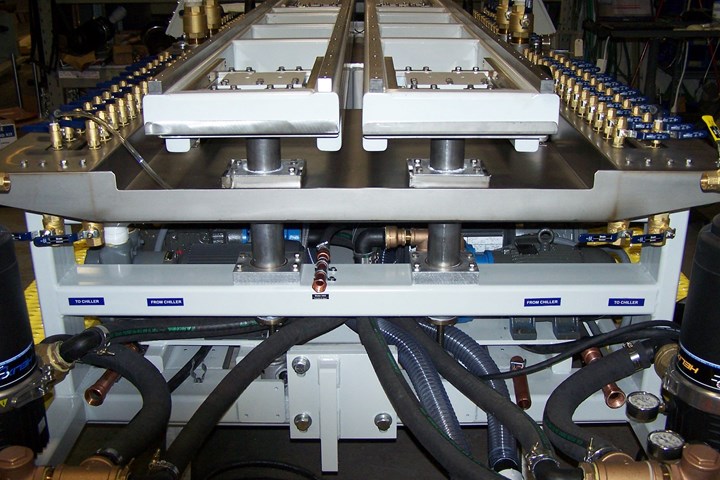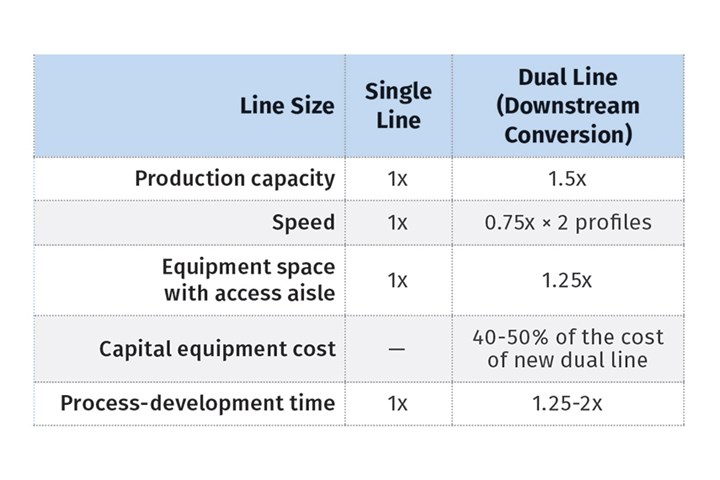While many industries have suffered during the coronavirus pandemic, some parts of the building-products industry have thrived. It’s clear that some consumers, stuck mostly at home, caught the DIY bug and took on “wish list” projects to help create more comfortable and enjoyable surroundings. One result has been increased demand for many types of profile extrusions, including everything from wood-plastic composite (WPC) decking and window profiles, to plastic lumber, PVC fencing products, siding, fascia and decorative trim items.
Upstream on the supply chain, plastic and WPC processors have welcomed the added demand for these extruded-profile building products. But for any extrusion processor, added demand raises questions about how to cost-effectively scale up production capacity. Recently, a number of extrusion processors have answered those questions by deciding to “go dual”—that is, to convert single-profile production lines into “dual-profile” lines to capture unused extruder capacity, or to scale up by installing new and larger, dual-profile lines instead of additional single lines.
Is that approach right for your operation? Start by asking yourself these questions:
1. Should I add new lines? If you are already running productive extrusion lines, the simplest way to dramatically expand production might be to add identical new lines. Depending on availability of space in your facility, you can simply install more of the same, based on exactly the same production model you currently use. So, there’s not much risk to making it work—you don’t have to push the edges of technology. What’s more, your personnel will already know exactly what to do. However, this approach is typically more expensive than the other alternatives.
2. Can I get more production out of what I already have? Maybe. If you are running your extruders at less than full capacity, it may be possible to increase production by speeding up the line. If you turn up your extruder rpm and can manage the increased output without compromising profile quality, it may be possible to increase line output by 10 to 20%.
Pulling more out of an existing extrusion line can certainly be a cost-effective approach, but it requires a willingness to risk some level of process redefinition, redevelopment, and experimentation to get the added throughput you’re seeking. And it’s not a sure thing, because there are a lot of variables: Increasing extruder speed increases shear, which can introduce process instability, profile stress, or dimensional problems. While existing tooling may work, you may find that you’ll need to lengthen or modify dies and downstream tooling. And you’ll need to adjust speeds, cooling capacity, and other settings on your downstream equipment. So, while it’s sometimes possible to get more out of equipment you already have, the potential upside is limited to approximately 20%.
3. Can I convert single lines to dual-profile lines? Or build new dual lines from scratch? Yes to both. Converting a single-profile line to a dual-profile line can be a wise investment if you have a single-line extruder with unused capacity of at least 50%. If you can sell that much additional output in the foreseeable future, then the payback numbers for converting to dual-line downstream equipment should be favorable. Dual-line conversion becomes an even more favorable option if you want to utilize excess extruder capacity but have limited facility space, or if you’ve already tried to speed up a single extruder line but have been unable to stabilize the output at the higher production rate.
Consider this example: A processor has an extruder with a rated output of 1500 lb/hr, but has been unable to stabilize output at more than 1000 lb/hr on a single downstream line. In many cases, it is possible to successfully convert that extrusion line to dual-profile production, utilizing full extruder capacity to drive two profiles that run at about 75% of the original single-line speed, totaling a production boost of 50%. And, because the dual extrusions are running at slower line speeds than the original single extrusion, process stability issues are far less likely to occur.

Processors that require larger production increases should compare the benefits of adding multiple single-profile lines with those of adopting larger-capacity dual-profile lines. For example, with the soaring popularity of maintenance-free WPC decking, some decking manufacturers have shifted their primary production from single lines running about 1500 lb/hr—or 700+ ft of 5/4 × 6 in. decking/hr—to larger dual lines running 3000 to 3300 lb/hr—or nearly 1600 ft of decking/hr.
Processors that require larger production increases should compare the benefits of adding multiple single-profile lines with those of adopting larger-capacity dual-profile lines.
Of course, packing twice the production capacity into a limited amount of space takes a lot of planning. Upstream, there’s the need to increase capacity for material handling and preparation. If you are extruding WPC, there is also a need for increased drying and pelletizing capacity. Because of the high moisture content of wood flour, hot-air drying is typically used to dry the compounded pellet. And, in certain applications, a second dehumidifying drying step may be required prior to extrusion. Then there’s the need for a larger extruder. Downstream, there’s the need to duplicate everything—from tooling to cooling, measurement, haul-off, and cutting/material handling.
Committing to dual-profile lines represents a major commitment of skill and resources. Compared with the single lines you’re used to running, it does take greater patience and effort to get these larger, higher-capacity lines stabilized and running smoothly, because you’re pushing the boundaries of the technology harder. But from a numbers standpoint, dual-line production can be a very wise investment (see sidebar).
To Go Dual, Work from What You Know
The key to success in switching from single-profile to dual-profile extrusion lines is to work from what you already know. Essentially, the idea is to create an identical second profile out of the extruder, and duplicate—as closely as possible—the tooling and process conditions already proven successful on the single-profile line.

The first challenge in successful dual-line production is in creating the dual melt stream at the extruder outlet. This involves development and installation of a “Y block,” a tool that splits the molten material into two equal streams. This output then flows through two identical die heads, providing two parallel profiles for downstream processing.
The second challenge is in stabilizing increased extruder output. Obviously, if you’re going to utilize excess capacity by extruding a second profile, the extruder is going to be running faster than it did before. And there will be a need to redefine and rework your process until extruder output is stabilized and dual profiles are successfully produced. Note that line speed, not extruder speed, is the key variable in profile quality. So long as the dual-profile output is running at or below 100% of the single-line speed, the profiles should be able to process through essentially the same downstream tooling and equipment with quality as good as the single-line profile product.
Looking Downstream
Downstream from the extrusion die, dual-profile equipment is essentially similar to single-line equipment, but duplicated and arranged in parallel. (For purposes of comparison, dual-profile equipment is typically of the same length and requires the same clearances as single-line equipment, but is about 50% wider.)
Many building-product extrusions—WPC decking, WPC or PVC window profiles, PVC fencing and the like—emerge from the extruder and are drawn “dry” through a series of sizing dies on a calibration table. The dies are equipped with internal water cooling so that they maintain an even temperature relative to the hot profiles, and may trickle drips of water to gently lubricate the profiles as they slide through. To help thin or complex profiles retain their shapes, some of these dies may draw a vacuum.
 Dual-sided spray tanks provide high-intensity evaporative spray cooling for larger profile extrusions or for profiles made of wood-plastic composites or other materials that have high cooling requirements.
Dual-sided spray tanks provide high-intensity evaporative spray cooling for larger profile extrusions or for profiles made of wood-plastic composites or other materials that have high cooling requirements.The profiles next enter a dual spray-cooling tank. Compared with immersion-style cooling, spray cooling is significantly more efficient. While immersion cooling tanks can allow for the development of an insulating “strata” of warmed water around a hot profile, spray tanks utilize more-efficient evaporative cooling to dissipate more heat more quickly. Spray cooling is a must for WPC extrusions like decking, since the heat index for their wood-flour component is much higher than that of typical polymer components in the composite mix. Tanks must also supply a much higher flow of cooling water for WPC profiles—up to three times more than is needed by ordinary plastic profiles. Spray cooling is also typical for large or complex vinyl extrusions used in window frames and fencing.
Extrusion processors considering production expansions owe it to themselves to consider a variety of alternatives.
The overall speed of the process is fine-tuned using a dual-line cleated puller, with speeds slaved to the master extrusion control. Though both of the cleated puller lines share a common equipment housing, the speed of each is controlled independently. So, each can fine-tune or “trim” process speeds by small increments based on the line speed and continuous feedback from the extrusion process controller. This is important because although dual extrusion lines are designed to perform identically, small variations in flow through the y-block and the extruder head are common, necessitating these fine adjustments. (Speed adjustments greater than 10% must be handled by adjusting the extruder rpm.)
Following the puller, the profiles next proceed to a dual-line saw table. Once again, the speed of each line—and the length of each profile—is managed by dual, independent measurement systems that drive dual saws. Profiles are cut to finished lengths and then pushed onto a dual dump table, which accumulates and then unloads cut lengths into stacks for pickup and packaging.
Extrusion processors considering production expansions owe it to themselves to consider a variety of alternatives. While installing new single production lines of capacity identical to existing lines is often simplest in terms of effort, it is typically the most costly in terms of capital and facility space costs. Adopting, or converting to, dual-profile production lines requires significant upfront planning and additional startup and process-development time, but can be significantly less costly in terms of capital and facility space, while scaling up the overall production capacity of your business.
ABOUT THE AUTHOR: Ernie Preiato is v.p., extrusion, for the Conair Group. Preiato joined Conair in 1988 and has focused on developing downstream solutions for processors of pipe, profile and tubing. Contact: 724-584-5423; epreiato@conairgroup.com; conairgroup.com
Related Content
Part 2 Medical Tubing: Use Simulation to Troubleshoot, Optimize Processing & Dies
Simulation can determine whether a die has regions of low shear rate and shear stress on the metal surface where the polymer would ultimately degrade, and can help processors design dies better suited for their projects.
Read MoreMedical Tubing: Use Simulation to Troubleshoot, Optimize Processing & Dies
Extrusion simulations can be useful in anticipating issues and running “what-if” scenarios to size extruders and design dies for extrusion projects. It should be used at early stages of any project to avoid trial and error and remaking tooling.
Read MoreUnderstanding Melting in Single-Screw Extruders
You can better visualize the melting process by “flipping” the observation point so the barrel appears to be turning clockwise around a stationary screw.
Read MoreHow Screw Design Can Boost Output of Single-Screw Extruders
Optimizing screw design for a lower discharge temperature has been shown to significantly increase output rate.
Read MoreRead Next
Dual-Strand Profile Line Gives Extruder Twice the Output
Steady growth in product demand and a full manufacturing floor required profile extruder Intralox to get creative when it needed to upgrade its equipment.
Read MoreHow To Size & Calibrate Profile Parts
Doing it right is critical to maintaining profile dimensions.
Read More























